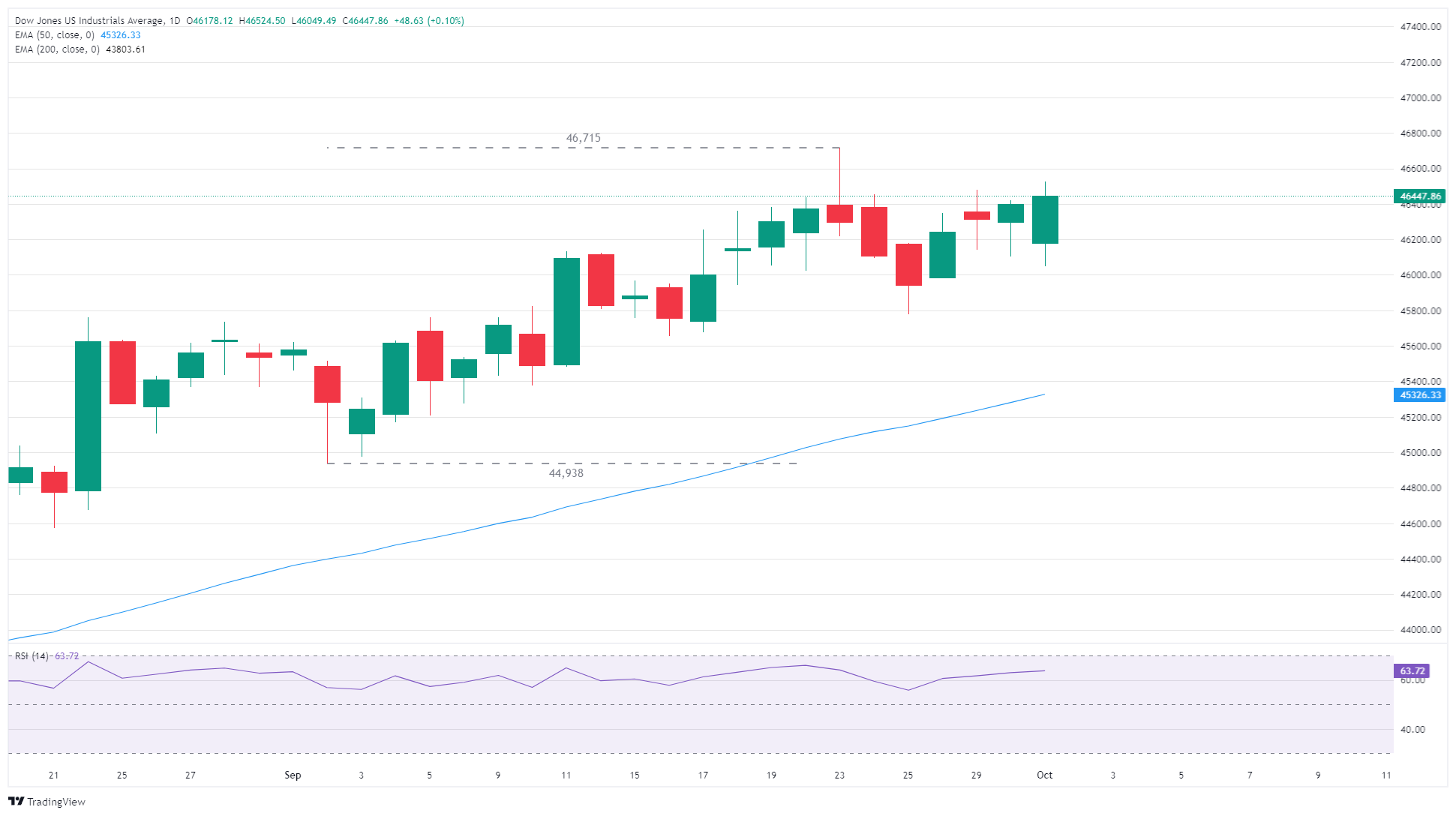Created
: 2025.10.02














![]() 2025.10.02 03:23
2025.10.02 03:23
The Dow Jones Industrial Average (DJIA) churned the chart paper on Wednesday, facing pre-market and early hour losses before recovering its stance enough to hold close to the 46,500 level. The Dow has remained in the same neighborhood since punching out new record highs a little over a week ago, keeping downside momentum at bay.
The US federal government is now in shutdown mode, with Congress unable to muscle a budget spending bill across the line before the regular start of the fiscal year on October 1, which occurs every single year and should come as no surprise to policymakers in Washington. Democrats have introduced two separate budget reconciliation bills this week, but House Republicans responded by skipping all budget meetings and remaining absent during two separate bill readings that would have provided a stopgap funding solution while a larger budget bill is considered.
Federal shutdowns have almost become the norm rather than the exception during Trump's presidency: This will be the fourth federal shutdown over budget disagreements that Trump has presided over across his two terms. The last federal shutdown, which occurred in 2018, lasted for 35 consecutive days and remains the longest government closure in US history. Donald Trump has a long-standing history of stating that any government shutdown is the fault of the president, as he declared in 2013 and 2011 by saying, "problems start from the top, and they have to get solved from the top and the president's the leader... he's got to get everybody in the room and he's got to lead."
ADP Employment Change figures came in much lower than the street expected, showing a contraction of -32K in September versus the expected 50K. August's initial print of 54K was also revised sharply lower to -3K. ADP jobs figures suffer from constant revisions, but the figure has generally missed expectations for all but three of the monthly figures published since the start of 2025.
The Bureau of Labor Statistics (BLS) is poised to delay or suspend the release of September's Nonfarm Payrolls (NFP) jobs report that was slated for this week. Initially due on Friday, the closure of the US federal government has made it difficult, if not impossible, for official data services to conduct regular operations. The NFP suspension comes at a time when markets are closely watching official labor data to suss out the Federal Reserve's (Fed) expected pace of rate cuts through the remainder of the year.
With the NFP print in jeopardy, investors are leaning further on private data such as ADP. According to the CME's FedWatch Tool, rate trader bets of another quarter-point interest rate cut on October 29 surged to 99% post-ADP on Wednesday. Rate markets are also pricing in nearly 90% odds of a third-straight rate trim on December 10, and a further 93% that the Fed will deliver a fourth interest rate cut by next April at the absolute latest.

The Dow Jones Industrial Average, one of the oldest stock market indices in the world, is compiled of the 30 most traded stocks in the US. The index is price-weighted rather than weighted by capitalization. It is calculated by summing the prices of the constituent stocks and dividing them by a factor, currently 0.152. The index was founded by Charles Dow, who also founded the Wall Street Journal. In later years it has been criticized for not being broadly representative enough because it only tracks 30 conglomerates, unlike broader indices such as the S&P 500.
Many different factors drive the Dow Jones Industrial Average (DJIA). The aggregate performance of the component companies revealed in quarterly company earnings reports is the main one. US and global macroeconomic data also contributes as it impacts on investor sentiment. The level of interest rates, set by the Federal Reserve (Fed), also influences the DJIA as it affects the cost of credit, on which many corporations are heavily reliant. Therefore, inflation can be a major driver as well as other metrics which impact the Fed decisions.
Dow Theory is a method for identifying the primary trend of the stock market developed by Charles Dow. A key step is to compare the direction of the Dow Jones Industrial Average (DJIA) and the Dow Jones Transportation Average (DJTA) and only follow trends where both are moving in the same direction. Volume is a confirmatory criteria. The theory uses elements of peak and trough analysis. Dow's theory posits three trend phases: accumulation, when smart money starts buying or selling; public participation, when the wider public joins in; and distribution, when the smart money exits.
There are a number of ways to trade the DJIA. One is to use ETFs which allow investors to trade the DJIA as a single security, rather than having to buy shares in all 30 constituent companies. A leading example is the SPDR Dow Jones Industrial Average ETF (DIA). DJIA futures contracts enable traders to speculate on the future value of the index and Options provide the right, but not the obligation, to buy or sell the index at a predetermined price in the future. Mutual funds enable investors to buy a share of a diversified portfolio of DJIA stocks thus providing exposure to the overall index.
![]()
Created
: 2025.10.02
![]()
Last updated
: 2025.10.02

FXStreet is a forex information website, delivering market analysis and news articles 24/7.
It features a number of articles contributed by well-known analysts, in addition to the ones by its editorial team.
Founded in 2000 by Francesc Riverola, a Spanish economist, it has grown to become a world-renowned information website.
We hope you find this article useful. Any comments or suggestions will be greatly appreciated.
We are also looking for writers with extensive experience in forex and crypto to join us.
please contact us at [email protected].
Disclaimer:
All information and content provided on this website is provided for informational purposes only and is not intended to solicit any investment. Although all efforts are made in order to ensure that the information is correct, no guarantee is provided for the accuracy of any content on this website. Any decision made shall be the responsibility of the investor and Myforex does not take any responsibility whatsoever regarding the use of any information provided herein.
The content provided on this website belongs to Myforex and, where stated, the relevant licensors. All rights are reserved by Myforex and the relevant licensors, and no content of this website, whether in full or in part, shall be copied or displayed elsewhere without the explicit written permission of the relevant copyright holder. If you wish to use any part of the content provided on this website, please ensure that you contact Myforex.
Myforex uses cookies to improve the convenience and functionality of this website. This website may include cookies not only by us but also by third parties (advertisers, log analysts, etc.) for the purpose of tracking the activities of users. Cookie policy